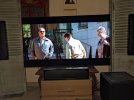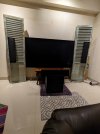So, this gives me a lot of leeway for front, but not much for rears.Four is better than two.
Of course.
The rear atmos I can not do anything beyond 25-30 degree without spoiling my viewing angle.
But I can mock a height speaker like the Dali alteco to act like rear atmos.



